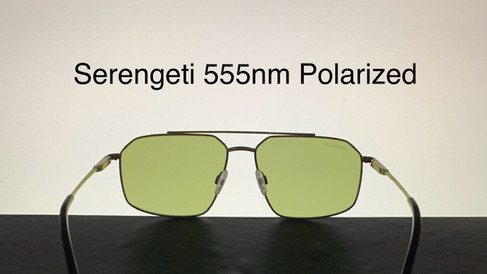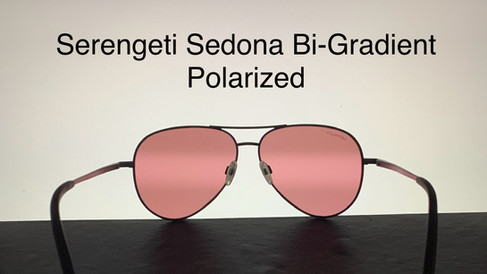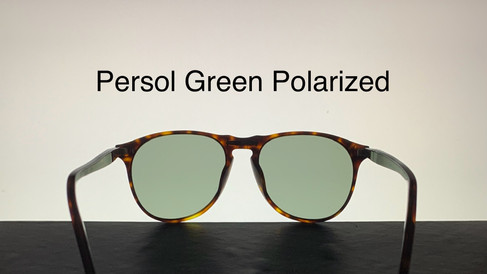Serengeti 555nm Blue Polarized Sunglasses Lens Review
- Sunglass Science
- Aug 9, 2024
- 10 min read
Updated: Nov 26, 2024
Serengeti makes some of the best sunglasses for bright and mixed conditions and the Serengeti 555nm Blue lens is easily one of the best bright conditions lenses on the market today.
Check out the Serengeti 555nm Blue lens on Amazon (which is often cheaper than Serengeti's website).
If you want to know more about how green lenses work, click here.
This Serengeti 555nm Blue lens review is only for the Serengeti 555nm Blue in mineral glass lenses, not the Saturn or PhD 2.0 lenses.
In This Review
Lens Specs | Serengeti 555nm Blue Polarized |
Technology | Spectral Control, Photochromic |
Lens Color | Green |
Mirror Color | Blue |
VLT | 8% to 25%, Category 2 to Category 3 |
ABBE | 58 |
Coatings | Anti-reflective, Scratch-resistant, Oleophobic, Hydrophobic, UV, Infrared and Blue-light blocking |
Material | Glass |
Weight | Moderate |
Scratch Resistance | High |
Prescription Available | Yes |
1 |
The Serengeti 555nm Blue lenses stand out for their exceptional clarity, thanks to the high-quality mineral glass and precise color tuning.
These mineral lenses, crafted from borosilicate optical glass by Corning, are 20% thinner and lighter than regular glass, providing outstanding visual clarity.
They are also chemically tempered, ensuring superior scratch and impact resistance.
All Serengeti lenses are photochromic, meaning they automatically adapt to changing light conditions. Activated by UV radiation, the lenses gradually darken or lighten based on the intensity of the sunlight. In bright conditions, UV radiation causes the lens molecules to expand, making the lenses darker to block more light. In dimmer settings, the molecules contract, allowing more light through for optimal visibility.
With a visible light transmission (VLT) range of 8% to 25%, these lenses shift between Category 2 and Category 3, slightly different from the 8% to 21% VLT of the standard 555nm lens.
While the 555nm Blue lens may seem a bit brighter than the standard version, the real difference lies in the enhanced color vibrancy, which we’ll explore further below.
Curious about whether these photochromic lenses darken behind a UV-blocking windshield? You can find that information here.
The lenses also feature Spectral Control, a light management technology that not only blocks harmful High Energy Blue light but also enhances color balance, contrast, and perception. Serengeti describes this technology as an "HD visual equalizer" that fine-tunes colors in all environments, making reds, greens, and yellows more vivid. This ensures landscapes look vibrant and well-defined, all while keeping your eyes relaxed.
The name "555nm" comes from the fact that 555 nanometers marks the center of the visible light spectrum, at the yellow-green boundary, where the human eye perceives light most effectively. As a result, though the lens has a dark tint, it still makes the view appear brighter by allowing more light at the optimal frequency for human vision.
Is the 555nm Blue lens available for prescription?
Yes, Serengeti is one of the few brands offering prescription mineral glass lenses.
Glass lenses are available +2.50 to -3.50* (Cyl +3.00) - Conventional surfacing and +2.50 to +4.00 and -3.50 to -7.00 * (Cyl +3.00) - VarioDrive Thin Design.
In Trivex, prescriptions can go from +6.00 to –8.00* (Cyl 4.00) for the Serengeti® sunglasses range.
Flightsunglasses.com has partnered with Serengeti to offer these prescription options, though many local providers may also offer them depending on location and availability.
For non-prescription versions, check out the Serengeti 555nm lenses on Amazon, which often offers them at a lower price than Serengeti's website.
For non-prescription, check out the Serengeti 555nm lens on Amazon (which is often cheaper than Serengeti's website).
How Does the Lens Look?
The front has a reflective blue mirror in a beautiful deep shade. It should be noted that the mirror is not as solid as other mirrored sunglasses and depending on the angle and lighting the mirror will not be as apparent, as the second picture shows. However, the view is completely uniform, with no changing colors around the edges like other non-solid mirrors, so the effect is due to the properties of the mirror, not any from any application issues.
The back has a blue shine from the anti-reflective coating. The color is yellow/green, relatively closer to the yellow side of the green spectrum than some other green lenses on the market, which can lean towards the bluer side of green. The blue mirror makes this lens even more yellow than the standard 555nm lens.

What Does the View Look Like?
Green lenses aren’t typically known for enhancing contrast, which is key for sports activities. Instead, they are favored for creating a more relaxing view by softening bright light and providing a relatively neutral visual experience. They are often used as a substitute for gray lenses.
What sets green lenses apart is their ability to provide a calming effect. They can have a darker tint than many other lens colors, yet still give a sense of brightness by enhancing the green tones that our eyes perceive.
The 555nm Blue lens stands out among green lenses. While it offers a more soothing view compared to warmer tints like brown or rose, it enhances colors in a unique way. It’s somewhat like the green counterpart to Maui Jim's Neutral Grey lens, or the dark version of Maui Jim's HT lens. The 555nm Blue lens amplifies colors more than the standard 555nm, with blues being reflected away by the blue mirror coating, allowing reds and greens to appear more vivid.
This combination of color enhancement, blue light blocking, and ideal tinting delivers an experience that makes everything appear sharp and clear on bright days. The lens offers a calming yet vibrant visual effect, where reds stand out brightly and blues take on a rich, pleasant tone, while still keeping greens bright.
Sunny Conditions
The 555nm Blue (and the 555nm) is, in my opinion, the best green lens for bright conditions, period. The view is comfortable, clear, and calm, but with colors balanced perfectly.
These photos are what Serengeti and other sources have used to show the view. Keep in mind that photos will never look as good as the real view looking through the sunglasses with your own eyes.
Interested in experiencing the Serengeti 555nm Blue lens for yourself? Check out the Serengeti 555nm lens on Amazon (which is often cheaper than Serengeti's website).

These pictures are what Serengeti uses on its product page for the 555nm Blue and 555nm but they do not represent a good view of the lenses. It is more accurate to say it they are a good depiction of the tint. You can see the 555nm Blue is slightly yellower but still green.

This picture, from Serengeti's 2018 catalog, is a fairly accurate depiction of what the lens can do in bright light. The green is the water is boosted and the rocks still have the reds brought out without overdoing it the way a brown lens might.
Here is my simulation of how the lens looks:
The 555nm feels brighter than a grey lens, while still calm and relaxing. The greens are brighter while the details in the sky, water, road, and buildings do not get washed out. A grey is redder in comparison and would feel a bit duller.
As long as it is a bright day, this lens performs excellently even in shadows.
Cloudy Conditions
The 555nm Blue lens performs better than many other green lenses in cloudy or overcast conditions, but it still doesn’t match the contrast offered by brown or rose lenses. While it does a decent job, the contrast isn't strong enough to fully counteract the gloomy effect that green lenses can have when the light is dim. It works well enough when clouds or shadows briefly block the sun, but it's not the best choice for days with little sunlight. That said, it does handle overcast conditions slightly better than the standard 555nm lens.


Optimal and Suboptimal Viewing Conditions
The 555nm Blue is best for green environments when keeping the greens boosted is desired or for red environments like dry or desert conditions when the reds are too much. I was happy with this lens where I live around the Great Lakes, but when I took it to work in Arizona in 120 degrees and blasting sun I really felt the magic of this lens. It absolutely thrives in hot and sunny conditions.
I rarely wear this lens in the winter, since there are few greens to boost and I’m looking at increasing contrast and color, something this lens doesn’t do much of compared to rose and brown.
It’s amazing at the beach, especially when the water has stark green highlights, which is often the case on lakes and even the ocean. I would take the 555nm Blue on any vacation to a sunny and colorful place.
Sports
I wouldn't recommend this lens for sports unless you live in an area with a lot of sunlight. Even then, a brown or rose lens will provide more color and contrast which help with acuity, comfort, vibrancy, and perception. This lens is better for relaxing in beautiful views.
Avoid the glass lens if the activity has any chance of significant impacts to the face. Avoid this lens entirely if polarized lenses would not work for your sport.
Keep in mind for long exposure in bright conditions brown may be fatiguing, and the 555nm Blue may be a good compromise in those situations.
Interested in experiencing the Serengeti 555nm Blue lens for yourself? Click here to buy on Amazon.
How the lens is marketed
About the 555nm lens, Serengeti says: "555 nanometers marks the center of light’s visible color spectrum, right on the border of yellow and green. This is where the human eye sees best. That’s why our 555nm lens was created specifically for optimal sight in bright climates. In low light conditions, this lens allows more yellow and green to pass through, creating relaxing conditions for the eyes. Because the brain can recognize these two colors most easily, yellow is widely used on caution signs while green on black are used on radar screens, night vision devices, LED displays and DVD players. Very bright light conditions — Ocean, Driving, and Everyday.
As a beautiful variation of the 555nm, the 555nm Blue features a reflective blue dielectric mirror coating, which offers a category 2 to 3 555nm lens protection that reflects more glare and improves contrast."
"Overcast to medium light conditions. Ideal for Everyday use."
Is the brand’s marketing accurate?
This is accurate and I think Serengeti can do a better job of marketing this lens, especially because it sells itself so well.
Comparison to the same brand - Serengeti
Serengeti 555nm Polarized
The 555nm lens is the same as the 555nm Blue but without the reflective blue mirror. Without the effect of the blue mirror the tint of the green lens a bit less towards yellow and more towards blue. This means it is less brightening than the 555nm Blue and a bit more relaxing. I prefer the 555nm and I keep it in my car, but I often wear the 555nm because it is a more formal look. For optics, I prefer the 555nm but the mirror does make an aesthetic difference that you should include in your consideration, as the 555nm is more versatile in how it looks.
See here for the full Serengeti 555nm review.
Serengeti Drivers Polarized
The Drivers lens is a wonderful brown lens that is the most color-enhancing and vibrant lens I have ever worn. The 555nm Blue is better in full light than the Drivers, as it is more calming, but the Drivers is more versatile and the views are more amazing in all other conditions. I view the 555nm Blue as a great full-sun condition compliment to the Drivers.
See here for the full Serengeti Drivers review.
Serengeti Sedona Polarized
The Sedona lens (here in its bi-gradient silver mirror version), is a rose-based lens that boosts reds and blues while keeping greens highlighted. This lens takes a minute to adjust to but quickly settles down to feel like a grey lens with the colors glowing with brightness and vibrance. The Sedona excels in bright haze, winter, golfing, and when you want to dial up the color to an even warmer and colorful degree. In some sense, the Sedona is the opposite of the 555nm Blue.
See here for the full Serengeti Sedona review.
Comparison to Green Lenses of Different Brands
Ray-Ban G15
Sort of the less colorful, more boring version of the 555nm, and even less than the 555nm Blue. The G15 is more blue than the yellower 555nm Blue. The Ray-Ban does not have all the coatings the 555nm does, only having an anti-reflective coating.
See here for the full Ray-Ban G15 review.
Randolph Engineering AGX/Cobalt
Compared to Serengeti 555 Blue the AGX is a lot more grey/blue and "calm"; putting Serengeti 555 Blue lenses on after wearing the AGX feels like someone turned the contrast and color saturation right up. I wear the AGX when I want the Randolph look or when I need an even calmer feel than the 555nm Blue provides. The AGX has all the coatings the 555nm Blue does.
See here for the full Randolph Engineering AGX review.
Revo Smokey Green
This lens is nearly identical to the AGX, and the differences are very hard to discern. The Revo is slightly more comfortable in direct sun and the AGX has slightly better color rendering, but it's really splitting hairs. Both are less vibrant and colorful than the 555nm Blue. The Smokey Green has all the coatings the 555nm Blue does.
Persol Green
A slightly more grey lens than the 555nm Blue. If you do not like grey but green is too much, it is a good in-between choice. Green is rarely too much though, as the same conditions the Persol excels in the 555nm Blue performs just as well if not better. The Persol does not have all the coatings the 555nm Blue does, only having an anti-reflective coating.
Conclusion - Serengeti 555nm Blue Lens Review - Should you buy it?
Serengeti makes some of the best sunglasses for bright and mixed conditions, and the Serengeti 555nm Blue lens is easily one of the best bright conditions lenses on the market today.
The combination of superior optical clarity, advanced photochromic technology, and exceptional color balance makes these lenses a standout choice. Whether you’re relaxing on the beach, driving through sun-soaked landscapes, or simply enjoying a sunny day, the Serengeti 555nm Blue lenses will provide unparalleled visual comfort and clarity. This is why it is a Tier 1 lens. If you value high-quality lenses and top-notch performance, the Serengeti 555nm Blue lens is definitely worth considering for your next pair of sunglasses.
Ready to experience the unparalleled visual comfort and clarity of the Serengeti 555nm Blue lens? Click here to buy now and upgrade your sunglasses today!




























